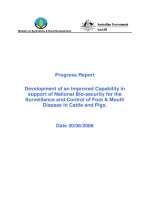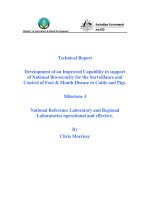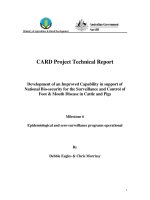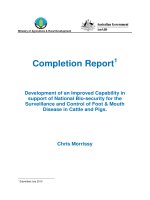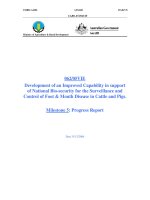Development of an intelligent electrolytic in process dressing (ELID) grinding system 5
Bạn đang xem bản rút gọn của tài liệu. Xem và tải ngay bản đầy đủ của tài liệu tại đây (365.86 KB, 22 trang )
Design and development of in-process truing for ELID grinding
93
Chapter 5
Design and development of in-process truing for ELID
grinding
5.1 Introduction
Ultra-precision grinding is a finishing process which is usually used for producing nano-
scale surface finish on both hard and brittle materials like ceramics, glasses, hardened
steels etc. In-order to achieve accuracy and process quality in precision grinding,
maintaining wheel profile uniformity is one of the major factors that should be taken into
consideration. The profile inaccuracy in the grinding wheel resulting from clamping error,
spindle run out and/or non-uniformity of the wheel may cause process instability and/or
surface damage on the finished products. Hence truing of the wheel is needed to eliminate
this error. There are several wheel truing methods available, which includes mechanical
contact methods (diamond dresser), electrothermal methods (electrical discharge
machining), laser technology, loose abrasive machining and electrochemical techniques
[3-15]. The working principle and the pros and cons of all these techniques were
discussed elaborately earlier in chapter 1 and chapter 2.
Electrochemical truing of the grinding wheel has more benefits over other methods
because of the system simplicity, low noise level, and less damage to the grinding wheel
Design and development of in-process truing for ELID grinding
94
as described in chapter 1. Electrolytic in-process dressing (ELID) is one of the
electrochemical methods for in-process dressing and truing of grinding wheels. However,
conventional ELID grinding does not use controlled dressing of the grinding wheel to
ensure acceptable grinding wheel profile [39-57]. Note that truing is the dressing of the
grinding wheel to maintain the profile uniformity. The work performed by Ashizuka et al.
[38] contributes greatly to the truing control of the grinding wheel by ELID, but it ignores
the concept of convolution, which is discussed in the later part of this chapter. To address
these drawbacks, a methodology has been proposed to control ELID power by measuring
the circumferential profile of the grinding wheel while considering the convolution
between the wheel and the electrode to ensure concentric wheel rotation.
In this setup, an inductive displacement sensor is used to measure the metal-bonded
grinding wheel profile. However, other methods of profile measurement such as
hydrodynamic pressure sensor, laser scanning micrometer are also available [70, 72].
This wheel profile data after proper conditioning is fed back to the controller to adjust the
pulse duty cycle of the ELID power supply. In this chapter, the theory and the simulation
of this novel concept as well as the experimental implementation are discussed
thoroughly.
In ELID grinding the metal bonded diamond wheel is continuously dressed and an
insulating oxide layer is formed along the circumference of the wheel. This layer is very
soft and brittle in nature and easily breaks off as it comes in contact with the workpiece.
The wheel truing method proposed in the current study makes use of this phenomenon.
Design and development of in-process truing for ELID grinding
95
The example of a non uniform wheel in figure 5.1(a) is used as a brief introduction to this
unique concept. However the idea is equally applicable in the case of wheel clamping
error or spindle run out problem. Figure 5.1(a) shows a high zone in the metal bond of
the grinding wheel. In order to achieve a uniform metal bond controlled dressing current
is applied during the pre-dressing of the wheel. This will cause higher metal dissolution
from the peak region of the wheel. Eventually after few cycles the grinding wheel will
become like the diagram in figure 5.1(b) which shows that a thicker ELID layer is formed
at the high portion of the wheel because of the controlled pre-dressing. However, this
excess layer will quickly wear off as grinding starts and finally the wheel-workpiece
contact shall be maintained uniform throughout the grinding cycle as shown in figure
5.1(c). In this hypothetical case, it is assumed that metal bond shall become completely
uniform during the pre-dressing, though this is not the case in actual machining. During
fifteen to twenty minutes of pre-dressing of the wheel the metal bond profile improves a
lot but it does not become completely uniform; therefore the controlled dressing of the
wheel has to be maintained throughout the grinding cycle to ensure consistent grinding.
Fig 5.1: (a) A typical example of non-uniform grinding wheel for ELID grinding
(b) Grinding wheel profile after applying proposed in-process truing (c) Wheel profile
after the grinding
Design and development of in-process truing for ELID grinding
96
5.2. Experimental procedure and signal processing
5.2.1 Experimental setup
A detailed schematic illustration of the experimental setup is shown in figure 5.2. In order
to implement the new wheel truing idea, the sensor integrated ELID grinding machine
(mentioned in the earlier chapters) was used. The experimental conditions are almost
same as the earlier experiments; explained in chapter 3 and chapter 4 except the pulse
duty ratio. However for readers’ better understanding these are described briefly in the
table 5.1. For the current study a Keyance inductive displacement sensor was used to
measure the metal bond profile of the grinding wheel. The optical sensor shown in the
figure is used to get the reference signal from the spindle mark so that the wheel profile
could be measured from the same starting point for every rotation. Figure 5.3 shows the
photograph of the inductive and optical sensor attached to the machine. Raw signal thus
obtained needs to undergo signal processing stage to use it for the control unit of the
current system.
Fig 5.2: Experimental setup for in-process truing
Design and development of in-process truing for ELID grinding
97
Fig 5.3: Sensor arrangement on the machine
Table 5.1: Experimental Conditions
Wheel Grit Size #4000
Wheel Diameter
75mm
Bond Material Cast Iron
Spindle Speed 750 RPM
In-Feed 3micron/cycle
Feed Rate 150mm/min
ELID voltage 90 v constant
Duity ratio Controlled by the wheel profile feed back
5.2.2 Signal processing
Inductive sensor applied in this study measures the distance between the sensor head and
the wheel metal bond. It is mounted on the setup in such a way that the distance measured
is equal the distance between cathode electrode and wheel metal bond. Usually in ELID
grinding, the cathode electrode covers the ¼th of the circumferential area of the wheel.
Therefore the data obtained by the sensor for one wheel revolution is divided into four
Optical sensor
Wheel
Inductive sensor
Design and development of in-process truing for ELID grinding
98
segments and the average values are calculated. As the wheel is rotating at a constant
speed, it can be seen from figure 5.4(a) and 5.4(b) that during one revolution of the wheel
moments will occur when two successive segments come together in the dressing zone.
Thus, the effective distance between the wheel and electrode shall be the weighted
average of the distances of two successive segments. The weighing factors can be
calculated by taking into account the convolution effect between wheel segments and
electrode area. Convolution is nothing but denotes the overlapped area between a
moving function and a stationary function in time domain. In-order to understand the data
processing let us denote the followings,
Fig 5.4: (a) The grinding wheel divided in four segments. (b)Two segments together into
the dressing zone (c) Relative position between A1 and A0 at time t=0 (d) Relative
position between A1 and A0 at 0 < t < T/4
Design and development of in-process truing for ELID grinding
99
Si is the average distance from the wheel to the electrode for ith segment, as shown in
figure 5.4 (a) ( i = 1 to 4)
Ai is the projected area function of ith segment which is assumed to be a rectangle
function of unit height in time domain as shown in figure 3(c) and figure 3(d)
A0 is projected area function of the electrode which is also assumed to be the rectangular
function of unit height in time domain as shown in figure 3(c) and figure 3(d)
T is the time for one revolution
t is time
s(t) is the actual average distance between wheel and electrode at time t.
y(t) is the convolution integral
At any time t (for
0 / 4
t T
< <
) the convolution integral y(t) between function A1 and A0
can be written as follows,
0
( ) 0( ) 1( )
t
y t A A t d t
τ τ τ
= − =
∫
for (0<t<T/4)
For this particular application the above mentioned convolution integral represents the
fraction of the overlapped area between moving segments of the wheel A1 and the
electrode A0. Therefore during time 0<t<T/4 the distance between the wheel and
electrode shall be the combination of S1 and S4, where fraction of S1 is a function of the
overlapped area between A1 and A0 as calculated by the above mentioned general
equation. By considering this, distance between wheel and electrode, s (t) can be
governed by the following equations for different time range,
Design and development of in-process truing for ELID grinding
100
s(t) = S4(1 –
4
t
T
⋅
) + (
4
t
T
⋅
- 0 )S1 for 0 < t < T/4 (5.1)
s(t)
= S1(2 –
4
t
T
⋅
) + (
4
t
T
⋅
– 1)S2 for T/4 < t < 2T/4 (5.2)
s(t) = S2(3 –
4
t
T
⋅
) + (
4
t
T
⋅
– 2)S3 for 2T/4 < t < 3T/4 (5.3)
s(t) = S3(4 –
4
t
T
⋅
) + (
4
t
T
⋅
– 3)S4 for 3T/4 < t < T (5.4)
In actual implementation, 500 points for one wheel revolution are measured to generate
the raw wheel profile. Then, the average distance between the wheel and electrode for
S1–S4 represents the average of 125 data points. Further, in order to calculate the actual
average wheel-electrode distance, the above equations ((1) to (4)) are used for which the
time interval is taken as 0.025T. Hence it is calculated at 40 equally spaced points on the
wheel circumference.
Figure 5.5(a) shows the raw wheel profile and figure 5.5(b) shows the corrected average
profile derived from equations (5.1) to (5.4). After these calculations the data is fed back
to the truing controller to output the desired pulse duty ratio at different segment of the
wheel. In the next section the design and development of such controller has been
discussed in detail.
Design and development of in-process truing for ELID grinding
101
Fig 5.5: (a) Raw profile for one wheel revolution (b) Corrected average profile for one
wheel revolution
5.3 Theory of a feedback controller for in-process truing in ELID grinding
5.3.1 Controller design
The objective of the proposed system is to vary the dressing power in a way that it
ensures consistent wheel-workpiece contact. This can be achieved if the metal bond of
the wheel is dressed to become uniform. This will lead to non-uniform ELID layer
formation on the wheel circumference. However, the excess layer will be broken off as it
interacts with the workpiece as shown in figure 5.1 previously.
In order to design such a controller a system model has been derived from Faraday’s
basic law of electrochemistry. Faraday’s law states the following,
( )( )
Idt M
dm
F z
= ……… …………………………………(5.5)
0
0.05
0.1
0.15
0.2
0.25
0.3
1 23 45 67 89 111 133 155 177 199 221 243 265 287 309 331 353 375 397 419 441 463 485
Different points on the Wheel Circumference
D i s ta n c e fr o m t h e s e n s o r h e a d in m m
Raw Wheel Profile
0
0.05
0.1
0.15
0.2
0.25
0.3
1 3 5 7 9 11 13 15 17 19 21 23 25 27 29 31 33 35 37 39
Different points on the wheel
C o r r e c t e d A v e r a g e d i s t a n c e f r o m s e n s o r
h e a d in m m
Average Profile
Design and development of in-process truing for ELID grinding
102
where,
dm
is the mass dissolved from the anode
I
is the average current flowing thru the ELID cell
dt
is the time of electrolysis
F
is the Faraday’s constant
M
is the molar mass of anode
z
is the valence number of the anode.
In the current study the power supply is designed to produce pulsed DC current for the
ELID cell. Hence equation 5.5 can be re written as follows,
( )( )
peak
rI dt
M
dm
F z
=
…………………………………. ……………………………….(5.6)
where
peak
I
is the peak current
r
is the pulse duty ratio.
Further from equation 5.6 the following can be deduced,
( )( )
peak
rI dt
M
dx
AF z
ρ
=
………………………………………………………………… (5.7)
where
dx
is the distance altered between electrode and metal bond of the wheel
ρ
is the density of anode
Design and development of in-process truing for ELID grinding
103
A
is the peripheral area of the wheel covered by the electrode.
As
peak
I
is kept constant in the power supply, the only parameter that can be controlled to
achieve the uniformity of the wheel is
r
. The following control unit illustrated in the
figure 5.6 is designed for this purpose.
min
r
Fig 5.6: Control unit for ELID truing
In the figure 5.6, x(n) is the array of distance value between the wheel and electrode for
different segment on the wheel after proper signal processing as explained in section
5.2.2. R is the reference target which is the maximum of x(n). K1 is the proportional gain
and K2/s [K2 is electrolytic constant] is the system model in s domain as proposed in
equation 5.7. The zero order hold block is necessary because the control signal needs to
be held constant for T/n time. In this particular study n is 40. The control signal r(n) for
nth segment is defined by the following equation,
max min min
( ( ))
( ) ( )
min( ( ))
R x n
r n r r r
R x n
−
= − +
−
……………………………………………… (5.8)
Design and development of in-process truing for ELID grinding
104
where,
max
r
is the maximum duty ratio allowed by the controller which is 0.99
min
r
is the minimum duty ratio allowed by the controller which is 0.01.
K1 can be deduced from equation 5.8 which is equal to
max min
( )
min( ( ))
r r
R x n
−
−
.
and
2 ( )( )
peak
I
M
K
AF z
ρ
=
As
min
r
is much lower than
max
r
; then this can be ignored in equation 5.8 for the
simulation purpose. However, in actual implementation it has been considered. Equation
5.8 can be rewritten as follows:
max
( ) ( ( ))
min( ( ))
r
r n R x n
R x n
= −
−
……………………………………………………….(5.9)
The control method described above is for one single wheel revolution; however several
wheel revolutions will be necessary for the complete elimination of the profile error.
Hence the K1 value will be changed for different iterations because in every iteration the
minimum of x(n) is changing. This new method of controlled pre-dressing of the wheel
will cause more oxide layer formation at the high zone of the wheel as explained earlier.
However, this error shall be reduced if the controlled dressing is applied during grinding
as well which is explained in the subsequent section.
Design and development of in-process truing for ELID grinding
105
5.3.2 Mathematical explanation for progressive error reduction in the wheel
profile
D
2
Fig 5.7: A non-uniform wheel touching the workpiece at one point
The non uniformity in the wheel should be eliminated both form insulating layer and
metal bond which can be achieved by controlled ELID truing. The metal bond profile of
the wheel shall become uniform as the truing control is applied, which is explained in the
earlier section. The insulating layer shall also become uniform as the wheel interacts with
the workpiece which is discussed in this section. Figure 5.7 shows three different angular
positions (1,2 and 3) on a non-uniform wheel. D1, D2 and Dn represents distances from
the wheel center to the edge for the respective positions. Now the initial profile error of
the wheel at these three different angles can be described as follows.
e1
0
= D1-Dn ……………………………………………………………………… (5.10)
e2
0
= D2-Dn………………………………………………………………………….(5.11)
Design and development of in-process truing for ELID grinding
106
e3
0
= D1-D2………………………………………………………………………….(5.12)
where,
e1, e2 and e3 are the wheel profile error at different angular position of the wheel.
Let us further denote
α1,α2
and
α
n
as the increase in layer thickness in one machining
cycle at different angular position of the wheel as shown in figure 5.7. Due to the
controlled electrochemical reaction
α
n is zero and
α1
is the maximum (
α
n<
α2<α1)
. Let
δ
be the in-feed (for simplicity
δ< α1)
in each machining cycle; after one machining
cycle equations 5.10 to 5.12 become as described below,
e1
1
= D1+
α1
-Dn-
δ
as the ELID layer is very soft and brittle in nature eventually excess layer shall be broken
off as it touches the workpiece; hence
α1 => 0
. Therefore,
e1
1
= D1-Dn-
δ =
e1
0
−δ (5.13)
and
e2
1
= D2+
α2−
Dn
= e2
0
+
α2
……………………………………………………………………… (5.14)
In order to generalize it is assumed that at the first in-feed of
δ
position 2 of the wheel
may not touch the work-piece.
e3
1
= D1-D2-
α2− δ
= e3
0
− α2 − δ
………………………………………………… (5.15)
Design and development of in-process truing for ELID grinding
107
From the above three equations it is clear that all the error except e2 are decreasing.
Although e2 is increasing it will cause D2 to become equal to D1 as predicted by
equation 5.14. Then overall error shall be decreasing at a rate governed by the equation
5.13. Eventually all the segments of the grinding wheel will become uniform which will
lead to a steady grinding.
5.4 Development of the system algorithm to implement in-process truing concept
A system was developed to implement the truing concept in ELID grinding. The flow
chart of the developed system is shown in figure 5.8. There are two programs one is in
the PC and the other one is programmed in the Intel 8051 microcontroller. The PC side
program does all the necessary calculations for generating the desired pulse duty ratio for
one wheel revolution whereas the controller side program generates the pulses and
captures the wheel profile data for one wheel revolution. The communication between the
controller and the PC is being done by RS232 serial communication.
At first a signal is sent from the PC to the microcontroller. On receiving this signal, the
microprocessor starts to wait for the interrupt input from the optical sensor as explained
in the section 5.2.1 .On receiving the interrupt; it measures a wheel profile and sends it to
the PC through RS232 communication. The PC program takes care about all the
necessary signal processing steps; calculates the desired pulse duty ratio for one wheel
revolution and sends the data to the microcontroller. After receiving the pulse duty ratio
data from the PC the microcontroller program again waits for the interrupt signal. Then it
Design and development of in-process truing for ELID grinding
108
generates the desired pulse duty ratio across the ELID cell upon receiving the interrupt
signal from the optical sensor, and the process repeats throughout the grinding cycle.
Fig 5.8: Flowchart of the truing control for ELID grinding
START
Send command to processor to collect
data for the wheel profile
Send data to the computer; desired pulse duty cycle is
determined by the computer for different wheel segments.
YES
Wait
NO
Processor received
the index signal?
Processor received the
index signal?
Processor generates the pulsed power
for the ELID wheel truing.
YES
Wait
NO
Send command to processor to generate desired pulse for
the ELID Cell
Design and development of in-process truing for ELID grinding
109
Figures 5.9 (a) shows the ELID current profile for one wheel revolution without in-
process truing where the pulse width is uniform throughout the revolution and figure 5.9
(b) shows the same after the above mentioned system is applied where the pulse width is
varied according to the wheel profile during one wheel revolution.
(a) (b)
Fig 5.9: Current profile for one wheel revolution (a) Without in-process truing (b) With
in-process truing
5.5 Results and discussions
The concept of wheel truing method described in the previous sections has been
practically implemented and thoroughly experimented to assess its performance. In this
section simulation results and experimental findings shall be presented and compared
extensively.
Index Signal
Current pulses
Design and development of in-process truing for ELID grinding
110
5.5.1 Study on the wheel metal bond profile
Figure 5.10 shows the simulation results of the designed controller using wheel profile
data measured by the inductive sensor. It can be observed from the figure that the metal
bond of the wheel becomes more uniform after several iterations.
5 10 15 20 25 30 35 40
100
150
200
250
300
350
nth segment
Distance s(t) (microns)
5 10 15 20 25 30 35 40
100
150
200
250
300
350
nth segment
Distance s(t) (microns)
5 10 15 20 25 30 35 40
100
150
200
250
300
350
nth segment
Distance s(t) (microns)
5 10 15 20 25 30 35 40
100
150
200
250
300
350
nth segment
Distance s(t) (microns)
Profile initial
Profile after 10min equivalent iteration
Profile after 20min equivalent iteration
Profile after 30min equivalent iteration
Fig 5.10: Simulation result of the proposed controller.
Figure 5.11 shows the experimental proof of improvement in the metal bond profile of
the grinding wheel after the pre-dressing. Figure 5.11(a) is the wheel profile after the
signal processing as explained in the previous section whereas figure 5.11(b) is the actual
metal bond profile. Significant improvement in the wheel profile can be observed in both
cases.
Design and development of in-process truing for ELID grinding
111
0
0.05
0.1
0.15
0.2
0.25
0.3
0.35
1 6 11 16 21 26 31 36
Wheel position
s(t) in mm
Profile after 10 min
Profile after 20 min
Profile after 30 min
Initial profile
0
0.05
0.1
0.15
0.2
0.25
0.3
0.35
1 28 55 82 109 136 163 190 217 244 271 298 325 352 379 406 433 460 487
Points on the wheel
Distance from the sensor head in mm
Initial Profile
Profile after 10min
Profile after 20min
profile after 30min
(a) (b)
Fig 5.11: Continuous improvement in the wheel profile with time; (a) Wheel profile after
signal processing (b) Actual wheel profile.
In the simulation
min
r
was considered to be equal to zero as mentioned earlier; hence in
the figure 5.10 the reference point in the wheel profile is not shifted. However in actual
implementation
min
r
was equal to 1%, therefore a shift in the wheel’s lowest point can
also be observed. Moreover if the simulation result in figure 5.10 and actual result in 5.11
are compared then it shall be observed that the rate of error reduction in wheel profile in
the simulation result is constant. This is because in simulation the increase in the
resistance value of the ELID cell because of the oxide layer formation is considered to be
negligible. In actual case there is a formation of the ELID layer during dressing of the
wheel which will reduce the effective dressing current and thus the error reduction rate in
the wheel profile shall eventually drop.
Design and development of in-process truing for ELID grinding
112
5.5.2 Study on the wheel/workpiece contact
The proposed truing method predicts a gradual improvement of wheel and workpiece
contact. As the in-process pulse width controlled dressing is applied on the wheel the
high portion of the wheel shall be dressed more to cause a higher amount of oxide layer
deposition at that portion of the wheel as explained in the earlier sections. As the grinding
progresses this extra oxide layer shall be worn off very fast and a good uniform wheel
workpiece contact shall be established throughout the grinding cycle.
In order to verify this, normal cutting force signal for one wheel revolution was measured
and compared for both types of grinding operation (with in-process truing, and without
in-process truing). A three axis Kistler dynamometer was used for this purpose. Figure
5.12(a) shows cutting force signal for one wheel revolution at different time of grinding
without in-process truing, whereas figure 5.12(b) shows the same with in-process truing.
-1
0
1
2
3
4
5
0
20
40
60
80
100
120
140
160
180
200
220
240
260
280
300
320
340
After 40 secs of
grinding
After 360 secs of
grinding
(a)
Design and development of in-process truing for ELID grinding
113
-5
0
5
10
15
20
25
0
20
40
60
80
100
120
140
160
180
200
220
240
260
280
300
320
340
After 40 seconds of
grinding
After 360 seconds
of grinding
After 680 seconds
of grinding
(b)
Fig 5.12: Normal cutting force signal for one wheel revolution at different time of
grinding (a) without in-process truing (b) with in-process truing.
It is very clear from these two figures that the wheel workpiece contact becomes more
uniform with progressive grinding when in-process truing is used.
5.6. Concluding remarks
The current study describes a novel approach of in-process truing by measuring the
circumferential wheel profile to realize uniform and consistent grinding. The following
salient points can be concluded from this chapter.
•
A wheel profile monitoring system has been developed and implemented. The
convolution effect has been taken into consideration to generate the feedback
signal for the truing controller to overcome the drawbacks of the previous system
[38]
.
Design and development of in-process truing for ELID grinding
114
•
A pulse width controllable power supply was developed for the in-process truing
of the grinding wheel. The wheel roundness and the wheel workpiece contact
have been improved significantly after implementing this power supply. Hence it
can be concluded that ELID is not only meant for wheel dressing alone, but in
addition a controlled dressing can be applied to achieve the uniformity of the
wheel thus a the need of separate system for wheel truing can be eliminated.
